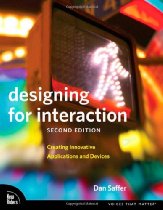This is a partial summary of Chapter 7 "Refinement" of Dan Saffer's book "Designing for interaction, 2nd edition".
The full summary is composed of four parts (check them out as well):
Controls
Most designs have some sort of visible controls to manipulate the features of the product (exception: voice and gestural interactions). Controls provide both the affordances needed to understand what the product is capable of, and the power to realize that capability. Some basic controls:
- Switch - toggle on / off
- Button - toggle button or that automatically resets (ex: keyboard)
- Radio button - allows users to select items in a set - used to constrain selection
- Dial - allows users to select a setting along a continuum or to choose between different settings or modes. Dials can move freely, or simply turn from an established point to other established point on a wheel. These points are called "detents". Some dials can be pushed in / pulled out (on / off).
- Latch - opens an otherwise tightly closed area. Useful for keeping some parts hidden or safe until needed. (ex: to open a battary compartment on a phone.
- Slider - like dials (but linear) - used for subtle control. Sliders with more than one handle can be used to set a range within a range.
- Handle - a protruding part of an object that allows it to be moved or resized (ex: handle on digital window).
- Physical-only controls: jog dial, joystick, trackball, 5-way.
- Digital-only controls: checkbox, twist, scroll bar, drop-down menu, multiple-selection list (or list box), text box, spin box. The combination of controls and the system response is called a widget. All applications and devices are made uop pf widgets.
Non-traditional Inputs
- Voice - (ex: Siri) A device typically has to be redy to receive voice commands.
- Gestures - (ex: Wii, smartphone accelerometers, Microsoft kinect) Issues to be aware of:
- physiology and kinesiology - limitations, such as "gorilla arm"
- presence and instruction - letting users know a gestural device is there and how to use it (ex: hands-free paper towel dispenser)
- avoiding "false positives" - avoiding unintentional human movements
- matching gesture to talk - figuring out the best motion to trigger an action
- Presence - (ex: automatic lights). Challenge: determine how and when a user can become "invisible" to presence-activated systems.
References and further readings
- Dan Saffer, "Designing for Interaction: Creating Innovative Applications and Devices", 2nd Edition, (2009), chapter 7
- The rest of the summary of Chapter 7 "Refinement": The Law and Principles of Interaction Design, Frameworks, Documentation and Methods of Refinement
- Human-Computer Interaction & Cognition: reading list

Comments